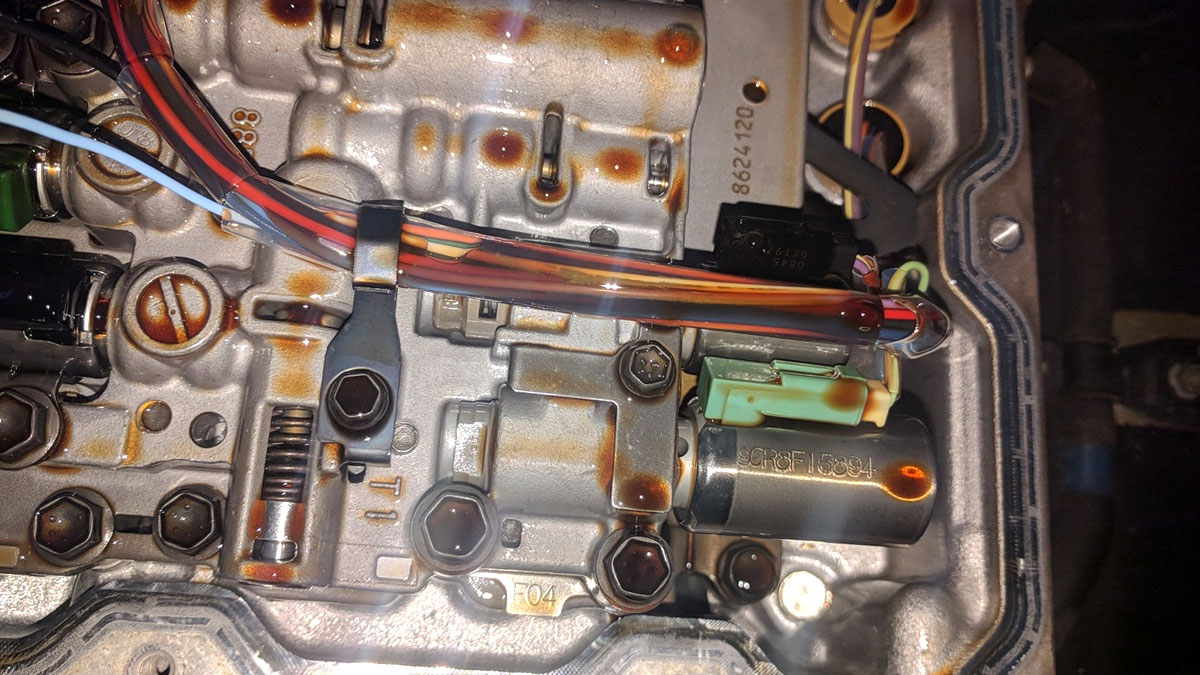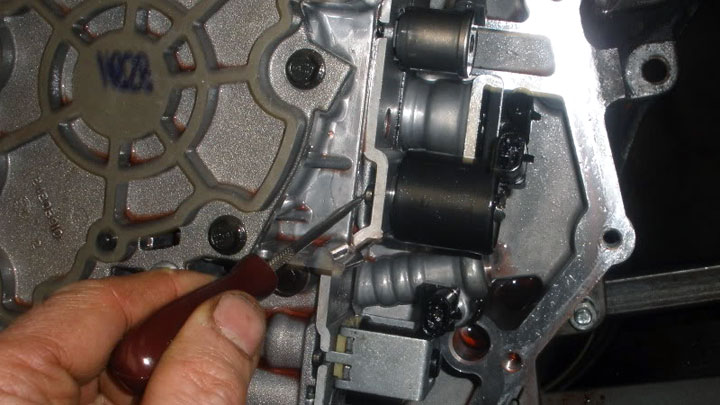5 Symptoms of a Bad Torque Converter Clutch Solenoid
The automatic transmission relies on many components working together, including clutch packs, shift solenoids, and the torque converter clutch (TCC) solenoid. This component regulates lockup of the torque converter to transfer power smoothly.
Failure of the TCC solenoid is surprisingly common in automatic transmissions. Let’s look at the common symptoms of a faulty torque converter clutch solenoid, what causes it to go bad, and how much it’s going to cost to replace the TCC solenoid.

What Is a Torque Converter Clutch Solenoid?
A torque converter clutch solenoid is a specialized electromagnetic device that opens and closes in response to requests by a vehicle’s transmission control module (TCM), in order to regulate the flow of transmission fluid to a vehicle’s torque converter.
In turn, the torque converter clutch solenoid plays a pivotal role in facilitating torque converter lockup. However, to better understand this fact, one must first familiarize themselves with the operation of the torque converter itself.
A vehicle’s torque converter is located between the rear (output) end of the engine, and the leading (input) end of the transmission. The torque converter serves as a viscous (fluid) coupling, which effectively disconnects the engine and transmission from one another when sitting idle, through controlled slippage.

As a vehicle reaches higher speeds, ample fluid is directed to the torque converter, facilitating 1:1 lockup. As a result, full engine power is then transferred to a vehicle’s transmission, and slippage is eliminated in its entirety.
As mentioned, this fluid delivery and resulting torque converter lockup, is accomplished through the operation of a vehicle’s torque converter clutch solenoid.
- In the open position, the torque converter clutch solenoid allows fluid delivery to the torque converter allowing lockup.
- In the closed position, the torque converter clutch reduces fluid delivery to the torque converter, allowing controlled slippage to take place.
Torque converter clutch solenoid failure is defined as the inability of the torque converter clutch solenoid to respond as anticipated to TCM commands.
Where Is the TCC Solenoid Located?
The torque converter clutch solenoid is located toward the front end of most vehicles’ transmissions, often directly in front of, or offset from, the transmission’s valve body.
In a number of cases, this solenoid is internal to the transmission housing itself and can be accessed only after dropping the transmission’s valve body/fluid pan.
Bad Torque Converter Clutch Solenoid Symptoms
The presence of a faulty or failing torque converter clutch solenoid is often accompanied by a host of secondary symptoms, some of which tend to be more noticeable than others. Early detection of these symptoms can prove valuable when attempting to make a timely repair.
The following are several of the most common symptoms associated with torque converter solenoid failure.
#1 – Illuminated Check Engine Light

Lack of proper torque converter operation generally results in the storage of one or more active diagnostic fault codes. Therefore, when a vehicle’s torque converter clutch solenoid fails, the illumination of a check engine light should be anticipated.
Some of the most common DTCs attributed to such a failure are P0740, P0741, P0742, P0743, P0744, P2769, and P2770.
#2 – Transmission Slippage

If a vehicle’s torque converter clutch solenoid is failed to the closed position, a motorist will often observe transmission slippage at highway speeds.
Oftentimes, this slipping often takes the form of erratic acceleration or hard, inconsistent shifts at higher speeds.
#3 – Stalling at Stops

On the other hand, if your vehicle’s torque converter clutch solenoid has failed to the open position, you might notice that your vehicle begins stalling when coming to a stop.
This is due to the fact that the affected vehicle’s torque converter will remain locked, thereby choking out an engine at lower speeds.
#4 – Activation of Limp Mode

Some vehicles are engineered to enter a derated state of performance if improper transmission operation is detected. This derated state is known as limp mode and often comes as the result of a torque converter clutch solenoid failure.
In many cases, a vehicle will reset from limp mode when turned off, only to re-enter limp mode once more as soon as highway speeds are achieved.
#5 – Shift Abnormalities
In many instances, the failure of a vehicle’s torque converter clutch solenoid will cause a number of shift-related abnormalities.
In some cases, a vehicle’s transmission will refuse to downshift from higher gears, while in others, a motorist might find that their vehicle appears to be stuck in neutral.
Finally, it’s almost certain that abnormally hard shifts will be experienced.
What Causes the Solenoid to Fail?

A torque converter clutch solenoid can fail for a number of reasons. One of the most common causes of failure relates to a lack of proper transmission fluid service.
Burnt, dirty, or otherwise degraded transmission fluid can quickly cause problems within the torque converter clutch solenoid itself, due to fouling and sticking of the internal portion of the valve.
Additionally, a vehicle’s torque converter clutch solenoid can fail at the hands of electrical abnormalities as well. Prolonged periods of high or low voltage delivery to this component’s coil cause eventual failure, thereby limiting or completely compromising the function of the torque converter clutch solenoid in its entirety.
Related: What Color is Your Transmission Fluid?
Torque Converter Clutch Solenoid Replacement Cost
Best places to order parts? See: 19 Best Online Auto Parts Stores

The exact cost associated with torque converter clutch solenoid replacement often varies considerably from one make and model of vehicle to the next.
This price differential comes courtesy of varying parts costs and fluctuating labor hour requirements for installation. Therefore, one or more quotes should be obtained for your exact make and model of vehicle before scheduling this type of repair.
Nonetheless, the median cost range for torque converter clutch solenoid replacement generally falls between $300-$750. Of this price, only a fraction ($50-$100) can be attributed to parts costs, while labor tends to command a steeper price of $200-$650.
Can You Drive With a Faulty TCC Solenoid?
While it is often possible to drive with a faulty torque converter clutch solenoid in most cases, doing so is not advised.
If failed to the open position, a vehicle will be prone to stalling at stops, causing hazardous operation. On the other hand, a TCC solenoid failed to the closed position will cause a vehicle’s transmission to slip at highway speeds.
In either case, the possibility of incurring additional transmission damage shouldn’t be ruled out, when attempting to drive for prolonged periods of time with a failed torque converter clutch solenoid.
This is a risk that is best avoided whenever possible, as internal transmission repair is often costly, to say the least.
In any event, the root cause of a vehicle’s TCC solenoid failure should be diagnosed and repaired as soon as possible. Doing so can quite possibly prevent you from being stranded along the roadside, and will minimize the risk of further mechanical issues from arising.
If you’re not comfortable doing the repairs yourself, schedule an appointment with a trusted service center as soon as you can.
- P0480 Code (Symptoms, Causes, and How to Fix) - Apr 19, 2024
- Car Temperature Gauge Stopped Working? (Here’s Why) - Apr 15, 2024
- Ignition Coil vs Coil Pack (What’s the Difference?) - Apr 8, 2024
